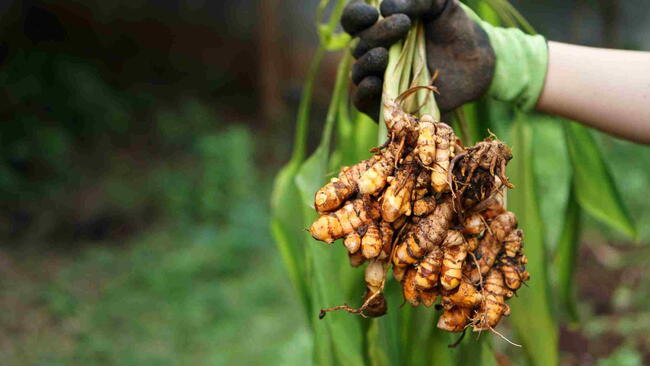Everyone has heard of turmeric as a cooking spice. But this powerful herb is also worth keeping on hand for its plethora of health benefits—especially inflammation (which affects so many parts of our body!). Turmeric can be grown and harvested in most climates. Learn more, plus I’ll share a turmeric drink recipe to give your body a boost.
What is Turmeric?
Turmeric (Curcuma longa) is in the Zingiberaceae family of aromatic perennial herbs—including ginger and cardamom—with creeping horizontal or tuberous rhizomes distributed throughout tropical Africa, Asia, and the Americas.
There are over 130 varieties of C. longa. This root has a deep history in South Asia and is known by more than 100 different Sanskrit names. Translated, they include “fortunate,” “give delight to the heart,” and “the one whose face is light and shining.”
In the Ayurvedic tradition, there are also many translations for turmeric, one of my favorites being “one who is victorious over diseases.” If you’ve read the book or seen the movie Dune, think of that powerful line, “He who controls the spice controls the universe.”
Turmeric is a healing superstar. See turmeric and the 5 spices that fight colds and flu.

Turmeric’s Many Uses
Archeological evidence shows that turmeric was used as a dye even before it was used as a food or medicine. The yellow/orange rhizome offers a yellow hue that can be used to dye cloth, foods such as cheeses, and even eggshells at Easter time.
The use of turmeric dates back nearly 4,000 years to the Vedic culture in India, where it was utilized as a culinary spice and had some religious significance. It probably reached China by 700 AD, East Africa by 800 AD, West Africa by 1200 AD, and Jamaica in the 18th century. It took until the early 1980s for it to be recognized in the Western world as an important medicinal plant.
India produces nearly 94% of the world’s total turmeric and is still the world leader in its use.
Turmeric and Inflammation
We cannot have a proper conversation about turmeric without talking about inflammation and its massive role in disease. Inflammation is a key player in ailments from heart disease to many autoimmune diseases and even cancer. Inflammation, a natural response to a pathogen or imbalance, tells us that our body is actively battling to keep us alive.
As the National Institutes of Health (NIH) states, turmeric “has been shown to exhibit anti-inflammatory, antimicrobial, antioxidant, and antineoplastic properties” worldwide.
Remember, our body is ALWAYS on our side. The pain and inflammation we experience is our body doing its best to keep us alive and well.
Chronic inflammation can also cause disease! We want the body to use inflammation for healing in the moment, but when it becomes chronic and systemic, a person can be prone to serious diseases and chronic pain.
Turmeric has risen to its heights of herbal fame because this plant can significantly reduce inflammation. So, while you’ll see below that turmeric offers a variety of healing gifts, we know that the main current of healing with this plant is helping the body to be less inflamed.
Turmeric’s Health Benefits
Now you can find one of turmeric’s chemical constituents, curcumin, sold as a supplement in every health food store. I personally believe in the power of using the whole plant as opposed to isolating one element or chemical.
Turmeric has a long list of uses related to inflammation, including helping with:
- Arthritis
- Skincare
- Respiratory conditions such as asthma
- Atherosclerosis
- Alzheimer’s disease
- Inflammatory GI diseases
- Urinary tract infections
- Protecting the liver
- Autoimmune diseases
- Allergies – seasonal and food
- Preventing chronic immune conditions, including cancer
- Lowering blood sugar
- Resolving bruises and sprains and moving stagnant blood
- Relieving gas and nausea
In folk medicine, turmeric has been used therapeutically for centuries in different parts of the world. In Ayurvedic practices, turmeric has been used to strengthen the body’s overall energy, relieve gas, dispel worms, improve digestion, regulate menstruation, dissolve gallstones, and relieve arthritis.
The beauty is that we can include turmeric in our daily meals and receive these benefits.

Growing Turmeric
Of course, you can find ground turmeric and turmeric supplements at your local grocery store with a click on the internet. However, growing our own plant medicine offers a layer of healing that no bottled herb can provide.
The connection we create with a plant when we grow it ourselves brings with it a healing energy that cannot be measured, though it is real all the same. When we use the whole root, we receive the freshest and purest form of plant medicine.
Turmeric loves to grow in hot tropical climates, although this healing root can easily be grown in cooler climates during the summer.

To grow your own turmeric, you will start with a healthy, fresh rhizome. I like to start with organic when I can. You can find turmeric root in some mainstream grocery stores or at your local international grocery store.
- Start growing turmeric in the winter, as it takes 8 to 10 months to reach full maturity, at which point you will see a nice, firm outer skin. So, depending on your zone, you might start from December to February.
- Using a large, open seed-starting tray, add high-quality potting soil, filling the tray halfway. Now, lay your turmeric roots gently on the soil. I like to give about 2 inches of space between roots. Cover your turmeric with more soil (about ½ inch or so) until the tray is full to the top. Water well.
- I have found that the key to starting turmeric, which loves heat, is keeping the tray on a seed-starting heat mat. I keep mine at about 80°F. Keep the soil nice and moist and wait patiently. It can take a month or longer to start seeing the green sprout of a leaf pop through the soil. I keep a grow light on during the day.
- Transplant in early June, well past the last frost date for my zone and when the evenings are not dipping lower than 50°F. I like to grow my turmeric in deep raised beds, planted 4 to 6 inches apart.
Turmeric is a rhizome, and as she first displays her leaves, they are big and paddle-shaped. As she grows throughout the summer, you will see more leaves popping up. Depending on the variety (there are over 100!) and where you are in the world, you could experience your turmeric flowering, which can range from red to white.
You can allow your turmeric to reach maturity, or you can harvest a little young before your first frost, which gives you a more supple, vibrant plant. See the Almanac’s complete Turmeric Growing Guide.
How to Use the Turmeric Harvest
If you grow more than you need, you can freeze your turmeric. I like to slice it up before freezing, which makes it easy to grab whatever amount you need at the moment. You can also dry your turmeric in a dehydrator and even grind it into powder yourself. Or, you can even juice it, and freeze the juice in ice cube trays to add to dishes.

Turmeric can, of course, be used as a spice in cooking. The earthy flavor and bright orange/yellow hue will bring a unique experience to your dish. Turmeric is a staple in Indian cuisine, lending many curries their classic golden hue. But also:
- You can take turmeric as a tincture and as a supplement.
- Add turmeric to elderberry syrup, as mentioned above.
- Use turmeric as a juice shot. I created this for my now-closed café, Ezra’s Enlightened Café. From day one, we sold our Immune Boost shot, and it has remained a staple and favorite among our customers. Many of our customers swore by this medicinal shot in preventing the flu, healing from feeling ill, providing energy, and even helping to soothe a headache.
Juice Recipe: Ginger Turmeric Immune Boost
Start with fresh ginger, fresh turmeric, fresh lemons, and raw honey. Juice one part turmeric, one part ginger, and two parts lemon. So, if you have ¼ cup of turmeric juice, you would want ¼ cup of ginger juice and ½ cup of lemon juice.
- Cut all ingredients small enough to fit into the tube of your juicer.
- Slice the lemons in wedges, keeping the rind on when feeding into the juicer.
- Juice the ginger first and set aside. Follow with the turmeric and set aside. Finish with the lemons and set aside.
- Now mix your juices in the above ratio: 1 part ginger, 1 part turmeric, and 2 parts lemon.
You can save this juice mixture in your refrigerator for up to 2 weeks.
To take your Immune Boost, pour 1 tablespoon into a small cup and drizzle a bit of honey into the juice. Sip to your health! It will be spicy, so be ready. This is a very powerful anti-inflammatory remedy.
This powerful plant medicine is easy to find and add to your life. Like I tell my Wild Moon Acres students, it will only work if you use it! Herbs don’t do anything for us sitting on the shelf. Have fun in the kitchen with turmeric and enjoy the many benefits!
Also, if you enjoy fermented drinks, see how to make this Kvass Drink With Turmeric for your health!
Contraindications
- Avoid using large quantities of turmeric during pregnancy; this is a theoretical concern due to the herb’s ability to “move blood.”
- In an RCT (Randomized Controlled Trial), turmeric and turmeric with aspirin had no significant effect on bleeding or platelet aggregation (Fung, et al., 2017).
- Turmeric contains significant levels of oxalates and should be avoided by people with calcium oxalate kidney stones and women with vulvodynia.
- Check with your doctor before taking significant amounts of turmeric to ensure it will not interact with any medications.
Note: I am not a medical doctor, and this is not medical advice. With any new herb, it is a good idea to check with your healthcare provider before adding it to your life. It is possible to be allergic to any herb. Listen to your body and only take something if it feels right for you. You are the #1 expert of your own body.














Comments